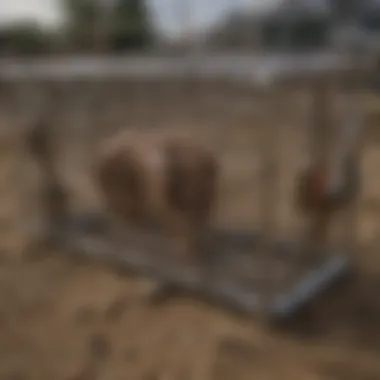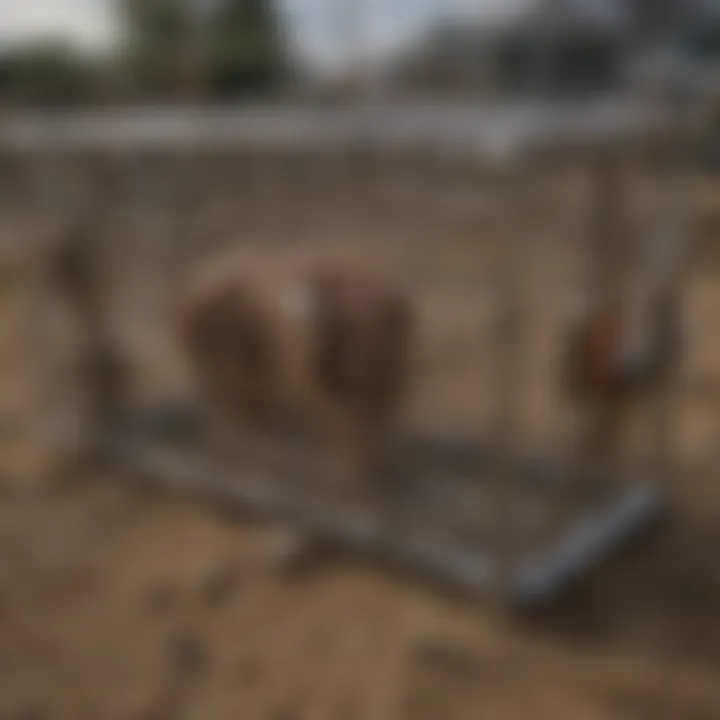Heavy Duty Live Animal Traps: Comprehensive Insights


Understanding Pests
Understanding pests is crucial for effective pest management. Pests are organisms that can cause damage to crops, property, or health. Common examples include rodents, insects, and certain birds. Identifying these pests is the first step in controlling them. Each type of pest may require different strategies for management.
Definition of Pests
Pests, in simple terms, are unwanted species that negatively impact human activities. This includes anything from the common house mouse to invasive insect species. These creatures often invade homes and gardens, seeking shelter and food. Their presence can lead to significant economic losses and health risks.
Importance of Pest Identification
Identifying the specific type of pest you are dealing with is essential. Proper identification informs your control methods. For example, different insects may respond to different treatments.
Understanding how to identify common pests can save time and resources. It also minimizes the risk of harming beneficial species. House owners need to familiarize themselves with the common signs of infestation, which can include droppings, gnaw marks, and unusual sounds at night.
Prevention Techniques
Preventing pest issues is often more effective than dealing with an existing infestation. There are several proactive measures that can be implemented to reduce the likelihood of pest entry into your home.
Home and Garden Preventative Measures
A well-maintained home and garden can deter pests effectively. Here are some strategies:
- Seal entry points: Inspect windows, doors, and foundation areas for gaps.
- Store food securely: Use airtight containers to keep food fresh and safe from pests.
- Regular cleaning: Keep your home clean, especially kitchens and dining areas.
Seasonal Prevention Tips
Each season brings its own set of potential pests. During winter, rodents often seek shelter. It is wise to check your home for entry points around this time. In spring and summer, insects like ants may become more active. Regular maintenance and monitoring can help prevent an infestation.
Eco-Friendly Pest Control Solutions
For those looking to minimize their environmental impact while managing pests, eco-friendly solutions are available. These methods are often safer for both humans and pets.
Overview of Sustainable Practices
There are various sustainable practices to consider:
- Integrated Pest Management (IPM): This approach combines various techniques for pest control, focusing on long-term prevention.
- Natural barriers: Planting certain flowers can deter pests naturally.
Natural Remedies and Their Effectiveness
Several natural remedies can be effective against common pests. For example, a mixture of vinegar and water can deter ants, while peppermint oil may repel rodents. While these solutions can help, their effectiveness varies based on the severity of the infestation:
"Natural remedies can complement other pest control methods, but they might not suffice for larger problems."
By understanding the characteristics of heavy-duty live animal traps and combining them with prevention techniques and eco-friendly solutions, house owners and housewives can manage pest problems more effectively, minimizing any potential hassle.
Prelims to Heavy Duty Live Animal Traps
The significance of heavy duty live animal traps cannot be overstated, especially in the context of effective pest management. As human habitats expand, encounters with wildlife become more frequent. Properly designed traps serve as essential tools in managing such interactions. They help in safely capturing animals that may pose risks to property, crops, or personal safety.
Heavy duty live animal traps are robust structures specifically designed for durability and efficiency. They are suitable for capturing larger species that require a stronger construction to withstand their strength. These traps are critical not only for homeowners but also for professionals involved in wildlife management.
The benefits of using heavy duty traps are multifaceted. First, they provide a humane option for capturing animals without causing them harm. This aligns with ethical considerations that are increasingly valued by society. Moreover, these traps minimize the risk of injury to both the traps and the animals.
Considerations related to the use of these traps include understanding local wildlife, knowing the specific animal species one might encounter, and adhering to relevant legal regulations. Familiarizing oneself with these factors will allow for more effective and responsible trapping practices.
In this article, we will explore various types of heavy duty live animal traps, their construction materials, key features, and best practices for use. The aim is to equip the reader with comprehensive knowledge enabling informed decisions when selecting and utilizing these traps.
Understanding the Need for Heavy Duty Traps
Heavy duty live animal traps serve a vital role in managing wildlife interaction with human environments. Understanding the need for these traps is essential for homeowners who may find themselves dealing with various wildlife nuisances. Whether it is raccoons raiding garbage cans, squirrels nesting in attics, or feral cats becoming a disturbance, effective trapping solutions are necessary for pest control.
One crucial aspect is the capacity of heavy duty traps to manage larger and more resilient animals. The typical traps found in stores often lack the strength required for overpowering animals. Heavy duty traps are designed with robust materials, thus providing the durability needed to withstand attempts of escape. By investing in high-quality traps, homeowners increase their chances of successfully capturing the target animal.
Furthermore, these traps are not just practical but also ethical. The emphasis on humane design ensures that captured animals experience minimal stress. This is important because ill-treated animals can lead to increased risks for injury and potential consequences for the property owner. Using heavier traps reflects a commitment to animal welfare while addressing pest issues effectively.
Also, local ecosystems can be affected by wild animal populations in urban settings. Overpopulation can lead to health risks and competition for resources. Heavy duty traps help keep animal numbers in check without resorting to inhumane methods. For homeowners, this means fostering a balanced environment that includes thoughtful pest management while respecting wildlife.
"Using heavy duty traps helps homeowners manage wildlife responsibly and ethically."
In addition, heavy duty traps often come equipped with user-friendly features. Many modern designs include easy set mechanisms and safe release options, minimizing hazards for both the person setting the trap and the captured animal. With this enhanced usability, managing wildlife becomes less of a daunting task.
Types of Live Animal Traps
Understanding the variety of live animal traps available is crucial for effective pest management. Each type is designed with specific functionality, catering to different species and situations. Knowing the options enables homeowners to select the right trap based on their needs and the behavior of the target animals. Efficiency in trapping not only ensures better results but also promotes humane treatment of wildlife, aligning with ethical considerations.
Box Traps
Box traps are a fundamental type of live animal trap, often used for capturing larger animals. Their design typically features an enclosure with a weighted door activated by the animal's weight. This configuration provides effective volume, allowing space for several small animals or a single larger one. The structure is generally made of metal for durability, which is essential for repeated use.
Some advantages of box traps include:


- Versatility: They can catch various animals from raccoons to groundhogs.
- Safety: The enclosed design minimizes injury risks to the animal, aligning with humane capturing practices.
- Ease of use: With straightforward setup processes, users can quickly deploy traps in the desired location.
However, one should also consider the placement of these traps. Inappropriate placement may lead to failures in capturing the target animal, making strategic location a priority.
Cage Traps
Cage traps provide another method for trapping live animals. These traps usually come in larger sizes, accommodating a variety of small to medium-sized wildlife. They consist of a bait channel that, when activated, results in the animal being trapped inside a cage. Crafted often from sturdy steel wire, they withstand significant wear.
Key aspects of cage traps include:
- Manageability: The design allows for easy transportation of the captured animal without direct contact.
- Effective Visibility: The open structure enables users to check the trap visually without disturbing it frequently.
- Multiple Capture Options: They are suitable for catching various animals like squirrels, skunks, or even rabbits.
When using cage traps, careful attention to bait is essential. Offering enticing bait increases the chances of a successful capture, ensuring animal welfare remains prioritized.
Funnel Traps
Funnel traps are generally less common but can be very effective in specific scenarios. These traps present a funnel-shaped entry that directs the animal into a holding area. Often used for smaller species, they can be set in various environments, including gardens and pathways. The constructed materials can vary, ranging from plastic to metal, depending on whether it is for temporary or long-term use.
The main advantages of funnel traps include:
- Space Efficiency: They often occupy less ground space compared to box and cage traps, making them suitable for tight areas.
- Natural Behavior Encouragement: The design motivates animals to enter without the perception of a hard surface, aligning with instinctive pathways and promoting humane capture.
Funnel traps, however, may require more skill in both placement and baiting. Understanding the behavior of the targeted species can help ensure these traps are effective.
Effective trap selection hinges on understanding specifics. Knowing the traps can significantly impact capture efficiency and animal welfare.
Materials Used in Heavy Duty Traps
Selecting the right materials for heavy duty live animal traps is crucial for ensuring their effectiveness and longevity. Different materials not only affect the durability of the trap but also influence its functionality, safety, and ease of use. The choice of materials impacts everything from the design of the trap to the convenience experienced by the user. In this section, we explore the two primary categories of materials: metal structures and plastic components. Each has distinct characteristics that need to be considered when choosing a trap suited to specific needs.
Metal Structures
Metal structures form the backbone of many heavy duty live animal traps. Typically made from steel or galvanized metal, these materials are recognized for their strength and resistance to wear and tear. As a consequence, traps constructed from metal are less likely to deform under pressure, enhancing their ability to capture larger animals without compromise.
- Durability: Metal traps can endure harsh weather conditions, making them suitable for outdoor use. They resist rust and corrosion, especially when galvanized coatings are applied.
- Safety: The strong framework prevents escaped animals, ensuring that captured species remain secure. This is vital for humane and effective trapping.
- Weight: While heavier than their plastic counterparts, metal traps provide stability. This heft can deter larger, stronger animals from tampering with or overturning the trap.
In summary, metal structures offer an ideal solution for serious trapping needs, combining strength with durability. However, care must be taken to inspect for signs of rust or damage over time, as these can affect the trap's performance.
Plastic Components
Plastic components are increasingly used in the construction of heavy duty traps. High-density polyethylene and other sturdy plastic materials contribute to making traps that are generally lighter than metal models.
- Lightweight: The reduced weight makes these traps easier to transport and set. This can be particularly beneficial for homeowners who may need to move traps frequently.
- Corrosion Resistance: Unlike metal, plastic does not rust, making it ideal for use in damp environments.
- Flexibility in Design: Plastics can be molded into various shapes, allowing for innovative trap designs that can appeal to specific species or environments.
- Affordability: Traps made from plastic are often less expensive than metal ones, making them accessible for a wider range of users.
However, while they offer benefits, plastic components might be less durable in extreme conditions or when dealing with larger animals, which must be carefully considered when selecting a trap.
Key Features of Heavy Duty Live Animal Traps
When considering heavy duty live animal traps, specific features are critical for effective performance. Understanding these features helps in making an informed choice that meets individual needs. Key features transcend basic functionality and contribute to an overall successful trapping experience.
Durability and Strength
Durability and strength are fundamental characteristics that define the quality of heavy duty live animal traps. These traps are often subjected to significant physical stress from both environmental elements and the animals they aim to capture. Thus, the materials used in construction play an essential role. Heavy duty metal traps, for example, are made from galvanized steel which resists rust and withstands harsh weather conditions.
Additionally, the strength of a trap ensures it can handle the weight and struggle of larger animals without failing. This aspect is crucial for not only effective capture but also for ensuring the trapped animal does not escape. A strong trap reduces the chances of damage, which is important for long-term investment.
Aspects to consider include:
- Material Quality: High-quality metals tend to perform better over time.
- Design Features: Reinforced corners and welds enhance stability.
- Weight Capacity: Always check the trap's specifications concerning the maximum weight it can hold.
A durable trap not only aids in animal capture but represents a responsible choice for pest management.
Ease of Use
The ease of use in heavy duty live animal traps cannot be overlooked. A well-designed trap simplifies the entire trapping process, making it accessible for individuals with varying levels of experience. Traps that are easy to set up save time and reduce the frustration that can come with complicated mechanisms.
Features contributing to ease of use might include:
- Simple Setup: Clear instructions and intuitive designs help users set traps quickly.
- Adjustable Settings: Some traps allow users to customize sensitivity levels for better results.
- Lightweight: While they need to be sturdy, traps that are lightweight can be moved and placed with greater ease.
By focusing on user experience, manufacturers ensure that even those new to trapping can engage in effective pest management strategies. An easy-to-use trap encourages the responsible handling of wildlife, ultimately fostering a better relationship between humans and nature.
"Choosing a trap that combines durability with ease of use can significantly improve your outcomes in live animal trapping."
Ultimately, recognizing these key features facilitates more informed decisions when selecting a heavy duty live animal trap, contributing to more effective and ethical trapping activities.
Selecting the Right Trap for Your Needs
Choosing the correct live animal trap is a key step in effective pest management. Heavy duty traps are specifically designed to handle larger and often more resilient animals. Selecting the right one can lead to more successful captures and minimize stress on the animals involved. The correct choice influences not only success rates but also the humane treatment of the animals. Understanding these factors is crucial.
Assessing the Target Animal


Identifying the species you aim to capture is the first and most important consideration. Different animals exhibit distinct behavioral traits and sizes. For instance, capturing raccoons requires a different approach than dealing with squirrels or larger animals like coyotes.
Consider the following aspects when assessing your target animal:
- Species Information: Research the habits of the animal. Knowing its preferred habitat and feeding times can help with trap placement.
- Physical Characteristics: Weight and size will dictate which trap is appropriate. Large animals need sturdier traps.
It is also essential to check local regulations concerning specific species. Some animals may have protections you need to be aware of.
Trap Size Considerations
Size significantly influences the effectiveness of a trap. If the trap is too small, it might not accommodate the animal properly. Conversely, a trap too large can lose the animal's interest. Here are factors to evaluate:
- Weight Capacity: Ensure the trap can support the weight of the intended animal. Traps like the Havahart 1079 live animal trap are suitable for a range of medium to large animals due to their robust design.
- Internal Dimensions: Analyze the size within the trap. Space is important for the comfort of the animal. Too much space may allow for dangerous movements.
- Accessibility: A trap should allow for easy entry and discourage escape attempts. The opening should be large enough for the target animal while not being overly spacious.
When selecting a trap, reviewing specifications provided by manufacturers is beneficial. This can ensure the trap chosen meets the needs based on size and the target animal.
"Capturing the right animal requires more than just luck; it demands careful thought and the right equipment."
Taking the time to assess animal characteristics and trap size ensures a successful and humane trapping experience. This selection process is essential for homeowners and individuals managing wildlife, leading to effective results.
Legal and Ethical Considerations
Understanding the legal and ethical considerations surrounding heavy duty live animal traps is crucial for anyone involved in pest management. This section delves into the responsibilities that come with trapping, highlighting the importance of adhering to local regulations and practicing humane methods.
Local Regulations on Animal Trapping
Local regulations vary significantly by region, making it essential to familiarize oneself with the laws governing animal trapping in specific areas. Many jurisdictions have strict guidelines that dictate which species can be trapped, the types of traps allowed, and the procedures to follow after capturing an animal.
Failure to comply with these regulations can result in penalties, including fines, or even criminal charges. Keeping up to date with changes in the law is necessary for responsible trapping practices. Individuals should consult local wildlife agencies or municipal offices to obtain information about trapping licenses and rules. Accessing resources such as Wikipedia can provide a foundation for understanding applicable laws.
Humane Capture Practices
Ethical considerations also extend to the methods used for capturing animals. Implementing humane capture practices is vital for minimizing stress and discomfort for the trapped animals. Heavy duty live animal traps should be designed not only for effectiveness but also for the welfare of the captured creatures.
Best practices for humane trapping include:
- Selecting appropriate traps: Ensure traps are suited for the specific species and capable of capturing without causing injury.
- Regular monitoring: Check traps frequently to reduce the time animals spend in confinement, helping to alleviate stress.
- Proper baiting techniques: Use bait that targets the intended species while avoiding harm to non-target animals.
Adopting humane practices is beneficial not only for the animals but also enhances the reputation of those who engage in trapping. Community organizations often appreciate and support methods that prioritize animal welfare, fostering trust among local residents.
"Humane trapping is not just about the animal welfare; it also reflects a commitment to responsible stewardship of wildlife and the environment."
Best Practices for Using Heavy Duty Live Animal Traps
Using heavy duty live animal traps effectively ensures successful captures while mitigating stress to animals and ensuring safety for users. Understanding the best practices is essential for efficiency and effectiveness in various scenarios, whether managing wildlife in urban settings or controlling pests in rural areas. This section explores key considerations to get the most from these traps, enhancing the overall trapping process.
Placement of Traps
The placement of traps is one of the most critical aspects. Proper installation can significantly affect the odds of capture. When deciding where to place a trap, consider the following points:
- High Traffic Areas: Place traps in locations where animals frequently travel. Look for tracks, droppings, or other signs of activity. Common spots include along fences, near food sources, and close to burrows.
- Sheltered Locations: Animals often seek cover for safety. Position traps in shaded or wooded areas that are less exposed to predators.
- Access to Water: Some species are drawn to water sources. If applicable, position traps near streams, ponds, or other water bodies.
The goal is to make the trap as appealing as possible while optimizing the chances for a successful catch.
Baiting Techniques
Baiting techniques can either make or break the success of your trapping efforts. Selecting the right bait and effectively applying it is crucial for attracting the target animal. Here are some recommendations:
- Choose Appropriate Bait: Select bait based on the specific animal you are targeting. Common choices include peanut butter for rodents, fruits for raccoons, and cat food for felines. Consider using strong-smelling items, as they are more likely to draw attention.
- Bait Placement: Place the bait deep within the trap to encourage the animal to fully enter. Position it at the rear so that the animal has to step on the trap trigger to reach it.
- Limit Non-Target Opportunities: If non-target species are a concern, adjust the bait or trap setup to reduce incidental captures. For instance, using less appealing bait can help.
The effectiveness of animal trapping relies heavily on proper trapping techniques. Failure to adhere to best practices can result in low capture rates and undue stress for animals.
Maintenance and Care of Traps
The proper maintenance and care of heavy duty live animal traps is crucial for ensuring their effective operation and longevity. These traps, while designed to withstand various environmental conditions, require regular attention to remain functional and reliable. Neglecting maintenance can lead to malfunction, which might prevent the trap from capturing intended targets or, worse, harm the animals inadvertently.
Cleaning and Storage
Cleaning of the traps should be a routine activity, especially after each use. This process helps remove any scent traces left by captured animals, which can deter future captures. A simple wash with soap and water can suffice, but ensuring all components are rinsed and free of residue is key.
- Consider using a brush to clean hard-to-reach areas.
- Allow the trap to dry completely before storing it to prevent rust or corrosion.
When it comes to storage, traps should be kept in a dry and safe location. This prevents damage from external elements and extends the life of the traps. It is advisable to store traps in an upright position or hung, if possible, to avoid warping or bending delicate parts. Using covers or materials that provide insulation can also protect the traps from extremes of temperature.
Regular cleaning and adequate storage practices are essential for the functionality of animal traps.
Inspection for Wear and Tear
Regular inspection for wear and tear is a necessity to ensure that traps remain safe and effective. This entails checking for any signs of rust, bent parts, or broken mechanisms. Damaged traps not only fail to operate as intended but could also present risks to the handlers and the animals being trapped.
- Look for the structural integrity of wires and meshes.
- Ensure that moving parts such as doors are functioning smoothly and do not stick.
- Replace any worn-out components promptly to avoid issues during trapping.


Keeping a maintenance schedule can help in timely inspections, thereby minimizing the risk of trap failure. It is also beneficial to document any repairs or replacements made for future reference.
Handling Captured Animals
One of the critical aspects of using heavy duty live animal traps is understanding how to handle captured animals effectively. This section focuses on the importance of minimizing the stress to the animal and ensuring safe transportation. Each of these factors profoundly impacts not only the welfare of the animal but also the efficiency of your pest management strategy.
Minimizing Stress for the Animal
When an animal is trapped, it can experience heightened stress. This stress may lead to severe behavioral changes and health risks. Thus, it is vital to lessen this stress during the handling process.
Here are some effective strategies for minimizing stress:
- Approach calmly: When you arrive at the trap, move slowly and avoid sudden movements. The goal is to maintain a serene environment.
- Cover the trap: Drape a light cloth over the trap. This simple act can provide the animal with a sense of security and reduce panic.
- Speak softly: Continuous, quiet reassurance can aid in calming the animal. Use a gentle voice to help it feel less threatened.
These techniques allow for a more humane experience for the captured animal, promoting its health and reducing the likelihood of injury.
Safe Transportation
After an animal is safely handled, the next step involves its transportation. It is essential to transport them safely to a location where they can be released or cared for. Here are critical considerations for this phase:
- Use a secure carrier: Opt for sturdy and well-ventilated carriers designed for animal transport. This practice minimizes escape chances and provides adequate airflow.
- Keep the carrier covered: Similar to covering the trap, covering the carrier with a cloth can help to keep the animal calm during transit.
- Avoid direct sunlight: Ensure the carrier is shaded from direct sunlight to prevent overheating, which can be particularly dangerous for trapped animals.
By implementing these practical steps for safe transportation, you help ensure the animal's well-being during this crucial phase.
Remember, the key to humane live trapping is to always prioritize the animal's welfare. Proper handling and transportation practices not only safeguard the animal but also promote a responsible approach to pest management.
Alternatives to Trapping
Exploring alternatives to trapping is crucial for any homeowner or individual concerned about addressing wildlife issues. While trapping can be a practical solution for certain situations, it may not always be the most suitable or humane option. The importance of considering alternatives stems from a recognition that other strategies can mitigate human-animal conflicts without resorting to traps. This section will discuss various options, primarily focusing on repellents and habitat modification techniques.
Repellents and Deterrents
Repellents serve as a frontline defense against unwanted animals. They work by emitting odors or sounds that deter animals from entering specific areas. For homeowners, this means they can protect their gardens, yards, or designated spaces without harm.
Here are some common repellents:
- Odor-Based Repellents: Products that contain natural compounds, like garlic or citrus, can create unpleasant environments for many animals.
- Ultrasonic Devices: These emit high-frequency sounds that humans cannot hear but are disturbing to many animal species, such as rodents and raccoons.
- Motion-Activated Sprinklers: These devices sense movement and release bursts of water, startling animals and keeping them away.
The efficacy of repellents can vary, and it is often beneficial to combine different types for a comprehensive approach. Regular application and movement of devices help maintain effectiveness, as animals can become accustomed to static deterrents.
Habitat Modification
Habitat modification involves altering the environment to make it less attractive to nuisance wildlife. This strategy is often more sustainable in the long term, as it addresses the root cause of the problem. Homeowners can implement several strategies in this regard:
- Remove Food Sources: Securing garbage bins and compost piles can reduce the appeal of areas to various animals like raccoons and squirrels. Individuals should also consider feeding pets indoors and cleaning up fallen fruit from gardens.
- Eliminate Shelter Options: Closing off access to decks, sheds, and crawl spaces discourages animals from nesting. This can be achieved by sealing gaps and using fencing where applicable.
- Maintain Landscaping: Keeping yards tidy by trimming overgrown vegetation and removing brush piles can reduce cover for wildlife. This makes yards less inviting to pests.
By integrating these methods, homeowners can create an environment that minimizes human-wildlife conflicts, promoting a healthier balance with local ecosystems.
"Using repellents and habitat modification is a proactive way to prevent animal intrusion without resorting to trapping or lethal measures."
Considering these alternatives acknowledges the need for humane treatment and environmental responsibility while protecting your home from unwanted guests.
Environmental Impact of Live Animal Trapping
Understanding the environmental impact of live animal trapping is crucial for informed decision-making in pest management. This section investigates how trapping methods influence local ecosystems, wildlife populations, and the overall health of the environment. By emphasizing the need for sustainable practices, we can help mitigate potential negative consequences associated with animal trapping.
Impact on Local Wildlife
Live animal trapping is often viewed as an effective solution for managing pest populations. However, it is essential to evaluate the repercussions of such techniques on local wildlife. Trapping can inadvertently affect non-target species, potentially leading to population declines or disruptions in local ecosystems. When traps are not used responsibly, they can catch species that were not intended for capture, which can result in stress and harm.
For example, rodents are commonly seen as pests, but many small mammals play important roles in their habitats. The indiscriminate nature of certain trapping methods may threaten these beneficial species. Additionally, captured animals can sometimes escape or be released in unfamiliar areas, which may introduce stress to their new environments and even lead to the spread of diseases or invasive species.
It is critical to consider these factors when engaging in live trapping. The responsible use of traps entails an assessment of the local wildlife and understanding the balance within the ecosystem. By taking appropriate measures to target specific species and avoid harming non-target animals, we minimize our ecological footprint and foster a healthier environment.
Sustainability Practices
Sustainability in live animal trapping involves implementing strategies that minimize ecological disruption while achieving effective pest control. Practitioners should prioritize methods that are designed to safeguard wildlife and promote environmental health. Here are some essential sustainability practices for animal trapping:
- Selective Trapping: Choose traps specifically designed for target species. This helps prevent unintended captures and reduces stress on non-target animals.
- Regular Monitoring: Frequently check traps to ensure that captured animals are handled promptly and humanely. This practice minimizes the time animals spend in confinement, reducing stress and potential harm.
- Ethical Baiting: Use baits that attract target species without being harmful. This also conserves energy, as only specific animals will be drawn to the traps.
- Releasing Captured Animals Responsibly: If translocation is needed, ensure that released animals are placed in suitable habitats where they can thrive without negatively impacting local ecosystems.
Implementing these sustainability practices not only maximizes the efficiency of live animal traps but also aligns pest management efforts with the goal of preserving ecological balance. Promoting responsible trapping ultimately benefits wildlife and enhances community awareness regarding environmental stewardship.
Ending
In the exploration of heavy duty live animal traps, it becomes evident that these tools serve a critical role in pest management for homeowners. Understanding their functionality and ethical implications is essential for effective use. Throughout the article, various aspects have been covered, reflecting on the importance of selecting the right trap, considering legal and ethical factors, and adopting best practices for both trapping and handling.
The significance of choosing an appropriate trap cannot be overstated. Every animal is different; hence, knowing the specific needs and characteristics of the target species can optimize the success rate. By selecting the right size, type, and design of the trap, homeowners ensure not only their effectiveness but also the safety of the captured animals.
Moreover, addressing local regulations on animal trapping and adhering to humane practices is vital. This helps maintain a balance between managing animal populations and protecting local wildlife. Awareness of these considerations enables homeowners to trap responsibly and ethically, contributing to a sense of community and environmental stewardship.
Best practices in placement and baiting can influence the efficiency and effectiveness of traps significantly. Homeowners must invest time in learning about proper techniques so that the traps serve their purpose without causing undue stress to the animals involved. Regular maintenance of the traps ensures they remain effective over time, preventing wastage of resources.
Ultimately, embracing heavier duty live animal traps reflects a commitment to responsible and effective pest management. This conclusion encompasses all the elements discussed, reminding readers of the need to approach trapping with thoughtful consideration and care. An informed approach to using these traps promotes sustainability, humane handling, and respect for wildlife, marking a positive step forward in pest management.
"The proper use of live animal traps necessitates an understanding that goes beyond mere functionality; it requires a commitment to ethical practices and environmental responsibility."
By synthesizing the information provided in this article, readers are encouraged to take a proactive approach in their pest management efforts. With the right knowledge and tools, they can navigate the complexities of trapping while ensuring the well-being of the animals involved.



